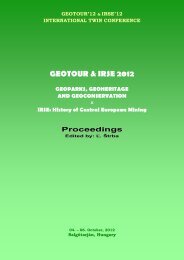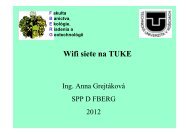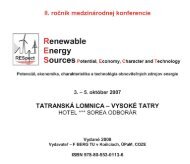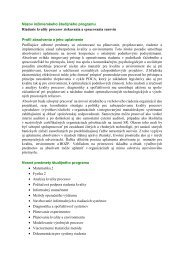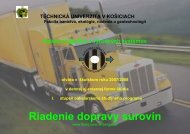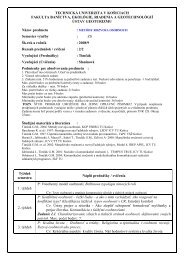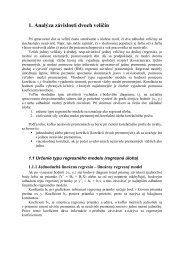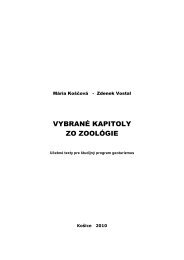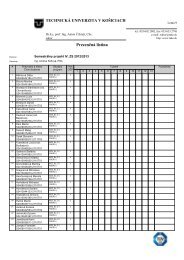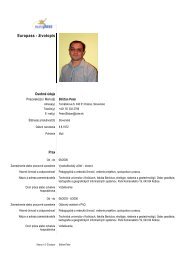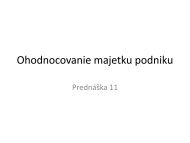GEOTOUR & IRSE 2012.pdf - Fakulta BERG - TUKE
GEOTOUR & IRSE 2012.pdf - Fakulta BERG - TUKE
GEOTOUR & IRSE 2012.pdf - Fakulta BERG - TUKE
You also want an ePaper? Increase the reach of your titles
YUMPU automatically turns print PDFs into web optimized ePapers that Google loves.
<strong>GEOTOUR</strong> & <strong>IRSE</strong> 2012<br />
HISTORICAL ORE MINING SITES IN LOWER SILESIA (POLAND) AS GEO-TOURISM<br />
AND INDUSTRIAL TOURISM ATTRACTION<br />
Maciej Madziarz<br />
KGHM CUPRUM Ltd Research & Development Centre, Wrocław<br />
e-mail: maciej.madziarz@pwr.wroc.pl<br />
ABSTRACT<br />
This article presents the possibilities of making use of the remains of several-century-old ore mining<br />
tradition in the area of Lower Silesia as major attractions of industrial tourism and geo-tourism, against a<br />
background of the mining development in that area and characteristics of the research and cataloguing<br />
work conducted systematically for many years at former mining and metallurgical sites by the Mining<br />
Institute of Wrocław University of Technology. The article presents a project for the preservation,<br />
conservation and modern-day use of the survived remains of tin and cobalt ore mining in the vicinity of<br />
Krobica-Gierczyn-Przecznica at the foot of the Izerskie Mountains in the neighbourhood of Świeradów<br />
Zdrój, which is executed by KGHM CUPRUM Sp. z o.o.<br />
LOWER SILESIAN ORE MINING IN HISTORICAL PERSPECTIVE<br />
„…There is land of such a nature that if you sow, it does not yield crops, but if you<br />
dig, it nourishes many more than if it had borne fruit …”<br />
This timeless thought was cited in the introduction to „De Re Metallica” – the first ever<br />
complex study concerning mining, metallurgy and mineralogy, by its author Georgius<br />
Agricola (actually Georg Bauer), a 16th-century researcher, scientist, physician and<br />
philosopher, one of the most eminent intellects of the Renaissance. The above maxim,<br />
expressed in ancient times by Greek philosopher Xenophanes, at least according to Agricola,<br />
and concerning the Athenian silver mines, perfectly reflects the importance of mining carried<br />
on over the ages in the area of Lower Silesia, especially in the Sudeten and their foothills,<br />
where adverse weather conditions and poor soils did not favour stock-farming and plantgrowing,<br />
and the real source of wealth and prosperity of their inhabitants were the treasures<br />
hidden deep in the mountains by the Nature. These treasures are made up of numerous<br />
mineral deposits, especially metal and ore deposits, including gold, silver and copper, the<br />
mining origin of which is covered with mists of history and can be traced back to as early as<br />
the bronze age. Although the territorial notion of Silesia underwent essential changes<br />
throughout its history, the mining of different ores had been successfully carried on here for<br />
many ages, and Lower Silesia distinctly emerged as the area of long-standing mining activity.<br />
To the north and to the east of its boundaries no mining activity had been carried on, it was<br />
only in the remote Bytom and Tarnowskie Góry region (the Polish Ore Basin) that mining<br />
activity was carried on a large scale. To the west, the nearest mining activity area was the<br />
remote region of Freiberg. It should be stressed that despite the distinct separation of the<br />
Lower Silesian mining, it took advantage of the experience of other, important mining centres<br />
in Europe, achieving a high level of mining (and metallurgic) technology [4]. Since the<br />
beginning of the 13th century the Silesia had been meant to embrace the land situated west of<br />
Przesieka Śląska, i.e. the border forests separating the Lower and Upper Silesia, and the land<br />
located east of Przesieka was called the Duchy of Opole. That distinction disappeared in the<br />
middle of the 15th century when the whole historical region of that land along with the<br />
Duchies of Upper Silesia was identified as the Silesia. However, in order to respect the old<br />
divisions, the notions of Lower Silesia - Silesia Inferior, Niederschlesien for the former<br />
Silesia and the Upper Silesia - Silesia Superior, Oberschlesien for the former Opole region<br />
were used. The Poland‟s borders on the Bóbr and Kwisa Rivers were established in the year<br />
101



